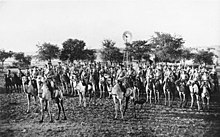Camel rider
Camel riders are a military force primarily in the Middle East and Africa . Camel riders often fought mounted like cavalry , especially from the end of the 19th century due to the development of weapons, mostly dismounted as mounted infantry . They were also used in wars of the 20th century, such as the First and Second World Wars , and in some rare cases are still used today.
history
In the course of history, camels (especially dromedaries of various breeds) were valued as mounts by the cavalry and other troops because of their positive qualities such as frugality and compatibility with horses .
The first mention of camel riders can be found on an Assyrian stele depicting a contingent of 1000 Arab camel riders in the Battle of Qarqar in 853 BC. Mentioned. Figures such Kamelreiter found on reliefs from Nimrud from the time of Assurbanipal (661-631 v. Chr.). Here, two riders armed with bows sit on a camel stallion, the one in front seems to be mainly busy steering it, while the one behind turns around and shoots at the Assyrian foot soldiers . The camel carries a kind of reins , but is steered with a stick, as it is today. A kind of saddlecloth is attached with straps around the chest and tail .
Historical missions by camel riders
- Malichus I sent in 48 BC BC Camel riders to Alexandria to support Julius Caesar .
- As part of the Egyptian expedition , Napoléon Bonaparte deployed cavalry units with camels.
- A special troop of imperial Germany formed the "camel riders" equipped with dromedaries of the protection force in German South West Africa , which were set up in 1904/07 under the governor Major Theodor Leutwein and the commander of the protection force Lieutenant General Lothar von Trotha . Its core was ultimately formed by the 7th and 8th Companies of the Schutztruppe, which were based on the edge of the Kalahari (in Gochas on Auob and Arahoab on Nossob) and, like the other Schutztruppe companies , fought as mounted infantry . In addition, the 3rd battery and supply troops were mounted with dromedaries. These troops were used as part of the Herero and Nama uprising . Stud farms existed in Kesslersbrunn and Kalkfontein . Due to the special legal position of the protection troops, they did not belong to the Reichsheer , but were directly subordinate to the German Kaiser .
- The US Camel Corps was only used in America for a short time.
- The Ichwan formed cavalry formations with camels in 1910.
- The British maintained various camel troops: the Camel Corps during the Gordon Relief Expedition 1884/85 in Sudan , the Imperial Camel Corps (in World War I), the Indian Bikaner Camel Corps (in World War I and II), the Somaliland Camel Corps and Sudan Camel Corps (called Hajana ). But camel troops were also used against the British, such as the Zumbooruck in the Middle East and in the Sikh wars .
- The French Foreign Legion had after the Second World War still Kamelreiter as Méharistes (in the méharistes Compagnies sahariennes were called).
- The Spaniards used the so-called Tropas Nómadas (nomad troops) in what is now Western Sahara
Current use of camels by the military and police
Dromedaries are still used today, for example by the UN peacekeeping forces (UNMEE) in Ethiopia and Eritrea. The Jordanian desert police stationed in Wadi Rum also use camels in addition to jeeps. The Mauritanian Army still maintains two battalions of camel riders.
A regiment mounted with camels is stationed in Jodhpur / Rajasthan as part of the Indian Border Security Force.
References
See also
- Rahla ( riding saddle)
- Tang Dynasty
- Friedrich von Erckert , called the father of the camel rider troop
- Battle of Umm Diwaykarat
- The camel rider as a figure in fairy tale chess
literature
- Robert Huré (ed.): L'Armee D'Afrique 1830-1962 . Charles-Lavauzelle, Paris 1977.
- Douglas Porch: The Conquest of the Sahara . Alfred a Knopf, 1984, ISBN 0-394-53086-1 .
- Piero Crociani: Le Uniformi Coloniali Libiche 1912-1942 . La Roccia, 1980.
- Jose Maria Bueno: Uniformes Militares de la Guerra Civil Espanola . Libreria Editorial San Martin, Madrid 1971.
- Ronald M. Nowak: Walker's Mammals of the World . 6th edition. Johns Hopkins University Press, Baltimore 1999, ISBN 0-8018-5789-9 (English).
- Walther Wülfing: At dawn against Kopper - The Kalahari Expedition against Simon Kopper . Windhoek 2010, ISBN 978-99945-71-72-7 .
Web links
Individual evidence
- ↑ www.politische-bildung-brandenburg.de: Das vorislamische Arabien page 58 ( Memento of the original from October 15, 2009 in the Internet Archive ) Info: The archive link was automatically inserted and not yet checked. Please check the original and archive link according to the instructions and then remove this notice. (PDF; 998 kB)
- ↑ Report on the camel riders of the Schutztruppe ( memento of the original from October 24, 2007 in the Internet Archive ) Info: The archive link has been inserted automatically and has not yet been checked. Please check the original and archive link according to the instructions and then remove this notice.



